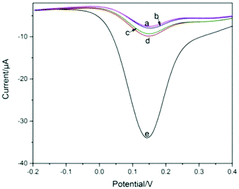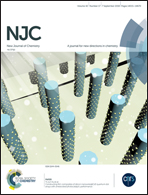Homogeneous electrochemical aptasensor based on a dual amplification strategy for sensitive detection of profenofos residues
Abstract
A homogeneous type of electrochemical aptasensor was designed based upon the principle of target-induced and tool enzyme-assisted signal amplification, which was employed for the detection of profenofos residues. In this experiment, profenofos, a type of organophosphorus pesticide, was used as a model target. The electrochemical signals of the aptasensor were acquired via electrostatic adsorption of negatively charged screen-printed electrodes (SPEs) and positively charged ferrocene (Fc). The ingeniously designed hairpin structure of the probe was unfolded with profenofos bound to the aptamer sequences, and after this, the target profenofos and the complementary DNA sequences with hairpin probes (HP) were separately recycled with the help of Vent polymerase and T7 exonuclease (T7 Exo). At the same time, due to the employment of T7 Exo, the Fc labeled DNA duplex could be digested into mononucleotides, making the end-labeled Fc approach the electrode surface and generate an enhanced electrochemical response. Based on this strategy, an ultrasensitive electrochemical aptasensor was fabricated with a low detection limit (LOD) of 0.01 ng mL−1. The developed method can be applied for the determination of profenofos residues in vegetables, and it produced satisfactory results.



 Please wait while we load your content...
Please wait while we load your content...